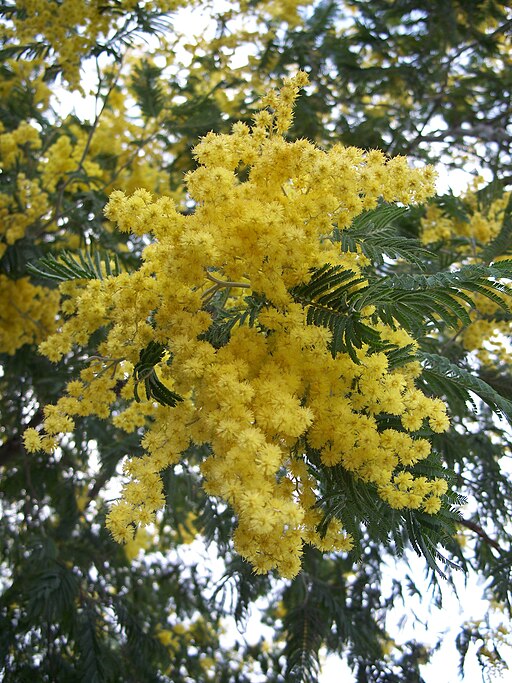Timberpedia - Mimosa / Silver Wattle
Mimosa / Silver Wattle
| Latin Name: | Irish Name: | Native to Ireland? |
|---|---|---|
| Acacia dealbata | No |
About the Tree
Evergreen Australasian tree having white or silvery bark and young leaves and yellow flowers.
“Silver wattle”. Very common tree of wet sclerophyll forest. Bi-pinnate foliage, slightly silvery.
Silver Wattle is a distinctive tree widely distributed throughout eucalypt forests and woodlands in
eastern Australia. It’s easily identified by its silvery blue-green feathery foliage and yellow flowers
during spring. In the past it has been more valued for horticultural uses than for its timber.
The tree grows very quickly and can reach heights up to 30m or more with a diameter of up to
75cm when mature. When grown in the open it develops a spreading habit and may form a crown
15m across. It generates readily after fire from soil-stored seed or root suckers. This means the
species is well-suited to the Australian bushfire environment
In Tasmania, Silver Wattle occurs as the dominant shrub in dry eucalypt forests and woodlands. It
can also be found as a tall understorey species in wet eucalypt forests. Silver Wattle is not very
long lived and dies out as the eucalypt overstorey matures. Supplies are readily available from
stands of regrowth which will be harvested on rotations between 70 and 90 years.
About the Wood
Easily split and relatively tough, it was used for furniture, clothes pegs, shoe heels, wood wool and
producing gum Arabic. Valuable for turning or small furniture items, and is used for cabinet work in
Tasmania. Tan bark has moderate levels of tannin for hide or fabric tanning; grown in South Africa
for this purpose.
Silver Wattle is striking light brown to subtle pink timber with an often distinct figure.
Drawn from trees of the same genus as the widely used Blackwood, its figure provides a
counterpoint to this closely related but darker species. Silver Wattle’s lighter tones mean it is increasingly in demand for furniture. Its very distinct rings can create a striped pattern when
backsawn that makes it an appealing timber for furniture designers and manufacturers.
When planed and dressed it produces a very smooth surface for furniture and it polishes well.
Know your wood! The Timberpedia is a broad resource that aims to catalogue all the major tree species in Ireland, containing information that we’ve gathered from over two decades maintaining our natural woodland and serving Ireland’s woodworking industry.
All written material is copyright © 2021 by the Lisnavagh Timber Project.
Timberpedia
- Acacia
- Alder (Common)
- Apple
- Apple (Crab)
- Apple (Japanese Crab)
- Ash
- Aspen (Trembling Poplar)
- Beech
- Beech (Copper)
- Beech (Southern)
- Birch
- Box
- Cedar (Western Red)
- Cedar of Lebanon
- Cherry (Bird)
- Cherry (Wild) / Gean
- Chestnut (Horse)
- Chestnut (Sweet / Spanish)
- Cypress (Lawson)
- Cypress (Monterey)
- Elm (English)
- Elm (Wych)
- Eucalyptus
- Fir (Douglas)
- Fir (Grand/Giant)
- Fir (Noble)
- Fir (Silver/European)
- Hawthorn
- Hazel
- Holly
- Hornbeam
- Ivy
- Laburnum
- Larch (European)
- Larch (Japanese)
- Larch (Red)
- Laurel
- Lime
- Maidenhair Tree
- Maple (Field)
- Maple (Norway)
- Mimosa / Silver Wattle
- Monkey-Puzzle
- Musk (Olearia)
- Oak (Cork)
- Oak (Holm / Holly / Evergreen)
- Oak (Pedunculate / English)
- Oak (Red)
- Oak (Sessile / Irish)
- Oak (Turkey)
- Pear
- Pine
- Pine (Scots)
- Plane (London / Lacewood)
- Poplar (Black Cottonwood / Western Balsam)
- Poplar (Grey)
- Rowan (Mountain Ash)
- Spruce (Norway)
- Spruce (Sitka)
- Sycamore
- Tulip Tree
- Walnut (Black)
- Walnut (Common)
- Wellingtonia
- Western Hemlock
- Whitebeam
- Wild Service Tree
- Willow
- Willow (Bay)
- Willow (Crack)
- Willow (Cricket Bat)
- Willow (Goat / Sallow)
- Willow (White / Silver)
- Yew (English)
- Yew (Irish)



